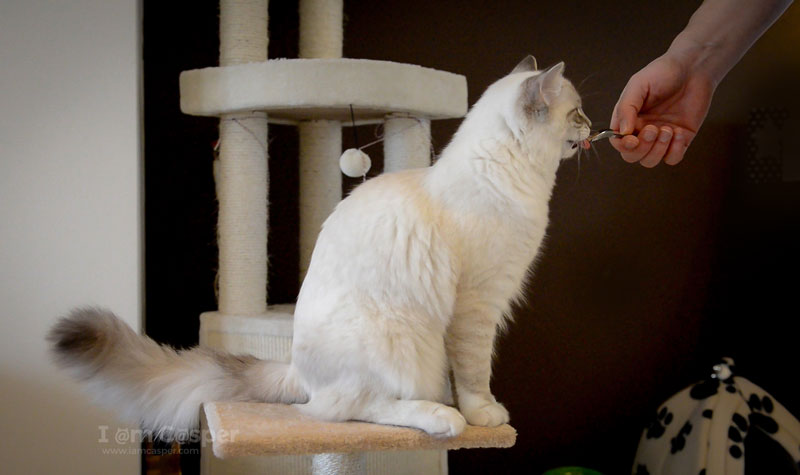CHARGING THE CLICKER – CLICKER TRAINING FOR CATS
Before you can do any clicker training on a cat you need to teach them what a clicker is. This process is called charging or conditioning the clicker.
What is needed for this exercise?
- A cat …
- A clicker
- About 10-15 food rewards (pea sized treats or other food rewards) – use high value foods as a reward, anything the cat really likes, meat or canned food.
VERY FIRST EXERCISE FOR ALL CLICKER TRAINING
We are going to ‘charge the clicker’ meaning we are going to create an association between the sound of the click and food. (connecting the food to the sound of the click)
The clicker’s unique and abrupt sound paired with food will help your cat clearly distinguish the moment they did something right.
For this initial exercise your cat does not has to do anything specific. Wait for the right moment (we don’t want the cat meowing or jumping), click and treat., pause for a second, do it again (the cat sits or looks at me), click and treat., and so on. Do the exercise when there is little to no distraction in the room.
You can toss the food on the ground or you can use a spoon to deliver the food when the food is more sticky. Using a spoon makes things less messy, as your cat will just lick the food from the spoon. If you don’t use a spoon, use pea sized treats. After you click place the reward on the ground. I like to use a spoon because it is easier to regulate how much food is on the spoon.
GOOD TIMING IS CRUCIAL IN CLICKER TRAINING
The cat gets a treat immediately AFTER the click. The ‘immediately after ’ is very important: the treat must not be given at exactly the same time as the clicking sound, because then no association would take place. In the beginning, a time span of half a second between the click and the treat is ideal.
This time span can get longer once the association has been firmly installed into the cats brain. But in the beginning half a second is ideal. If the period of time elapsing between the clicking sound and the giving of the treat is too long, you will also fail to achieve a conditioning effect, because your cannot make a connection between the click and the treat.
MULTIPLE SHORT TRAINING SESSIONS WORK THE BEST
So you take the clicker in your hand, put a few treats easy to reach nearby, and call your cat towards you. Only click once each time, and give him the treat within half a second. Repeat this a few times. And whether you believe it, or not, you are well on your way to classically conditioning your cat!
Do about 8 to 10 clicks and treats in one exercise session. A session won’t any take longer than 2-3 minutes maximum. Do about 4 sessions in two days to allow your cat to make and remember the association between the click and the food. Only then you are ready for the next step in clicker training.
Within a short period of time you will notice that your cat has made a connection between the click and the treat. With clicker training you can teach your cat all sort of things. In our next video I will show you how to teach Sit to a cat using clicker training.
Pay attention not to move the clicker hand, you can hide it behind your body. You don’t need to give commands, speak to your cat and don’t make any specific body movements, because they will be interpreted as a unwanted clues.
Try it now and give us your feedback and comments on this first exercise in the comment section below. Looking forward to read how you did…
VIDEO DEMONSTRATION WITH CASPER – CHARGING THE CLICKER
Please don’t forget to give us a comment here below on this blogpost or in the comment section on our Youtube Channel. If you want to see more of Casper and his adventures, don’t forget to subscribe.
ANOTHER INTERESTING READ
If you want to learn more about Clicker Training for Cats, then I recommend you to take a look at :
You can also find more interesting information about Casper our ragdoll, about Cat Photography, Social Media for Cats or our Outdoor Cat Adventures via the START HERE page.



